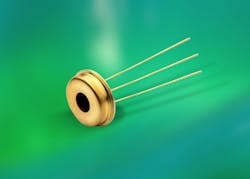Radiation-Hard Photodiodes for Electron Detection
Opto Diode introduces the 20 mm2 photodiode with a circular active area that is ideal for electron detection. The new device offers 100 percent internal quantum efficiency (QE) and unparalleled stability.
The absence of a surface dead region results in 100 percent collection efficiency. The radiation-hard, junction-passivating, oxynitride protective entrance window makes the device extremely stable even after exposure to intense flux of UV photons (showing less than 2 percent responsivity degradation after megajoules/cm2 of 254 nm and tens of kilojoules/cm2 of 193 nm photon exposure). The exceptional radiation-hardness makes these diodes much better suited than conventional silicon photodiodes for space missions and/or satellite applications.
The new device features a rise time of 1.7 µsec (typical), a minimum rise time of 0.8 µsec, and a maximum of 3.3 µsec. The shunt resistance is 200 MΩ (typical), 50 MΩ (minimum), and the typical capacitance is 4 nanofarads (nF), maximum is 10 nF. Housed in a TO-8 package, the UVG20C offers peak responsivity of 800nm at approx. 0.56 A/W.
Opto Diode's UVG20C absolute devices' thermal parameters offer storage temperatures ranging from -20 °C to 100 °C; operating temperatures range from -20 °C to 80 °C. The maximum junction temperature is 100 °C and the lead soldering temperature (1 /16 in. from the case for 10 seconds) is 240 °C. The new radiation-hard photodiodes for electron detection are available for shipping now.
